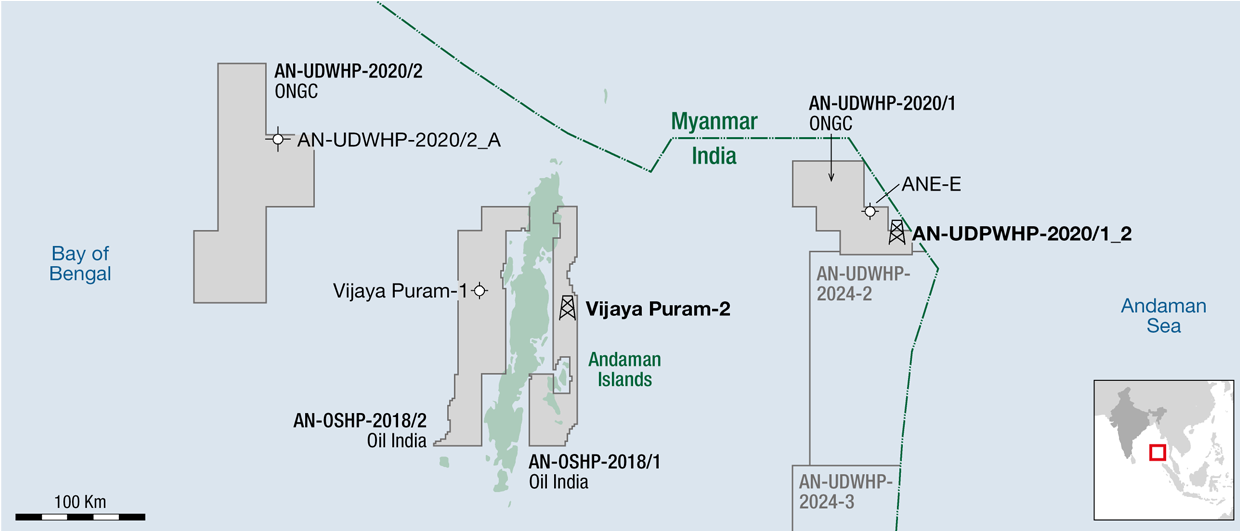The Digboi oil field lies in the remote north-eastern corner of Assam in India near the borders with Myanmar and China. Discovered in 1889, it can probably claim to be the oldest producing oil field in the world and its refinery from 1901 the oldest operating refinery.
It is also fair to say that this is the birthplace of the oil industry in India.
Currently, the state-owned Oil India Ltd handles exploration and production, while the Indian Oil Corporation Ltd. is responsible for refining and marketing. Although Digboi field itself is close to abandonment, the refinery has been considerably modernized from the 1990s onwards, and now can process up to 13,000 bopd of crude oil from numerous oil fields in the region.
The refinery lies near the town of Digboi itself (population 100,000), a bustling place with markets, schools, hospitals, social clubs, an oil industry museum, a war cemetery, and even an 18-hole golf course.

Numerous oil fields
The field is located on the south bank of the Brahmaputra River near the NE end of the Assam Shelf. To the east, the Shelf is bound by the Naga Hills, the site of a major thrust fault. The region lies in the subduction zone between the Indian Plate, which split off from Gondwanaland in the Jurassic/Cretaceous and moved north colliding with the Eurasian/Burma plates. Uplift of the Himalayas and subduction of the Indian plate continues to the present day.
Sediments derived by erosion of the rapidly uplifted Himalayas and Indo-Burman mountains were deposited on the Shelf reaching a thickness of up to 7000 m close to the Naga Hills thrust fault. They comprise shallow marine and deltaic sandstones, siltstones, shales, and coals as well as platform carbonates, ranging in age from Eocene to Miocene.
The oil is sourced from shales and coals, while sandstones and carbonates form the reservoirs. Simple and faulted anticlines are the most frequent trap types.
Digboi field is hosted by an elongate anticline at relatively shallow depth. Exploration from the 1940s to the present day has resulted in the discovery of a further 40 oil fields over a distance of 300 km. Reservoir depths are generally between 2500-4000m. The largest fields – Nahorkatia, Moran and Lakwa fields discovered in the period 1953-1964 – each contain more the 500 MMboe (!) reserves.
Finding oil with elephants
Oil from natural seepages has been used for hundreds of years both in Assam and neighbouring Myanmar.
During the 1800s, as the region came under the influence of the British, accounts of the seeps begin to emerge in the journals of army men as well as other explorers. One of the earliest was penned by the British doctor and botanist William Griffith, who visited the area around 1835 in his quest to establish tea plantations. He notes about the Kamroop river near Digboi: “The only curious things about it are the petroleum wells, which are confined to three situations. The wells are most numerous towards the summits of the range, and the place where they occur is free from shrubs. The petroleum is of all colours, from green to bluish-white; this last is the strongest, partaking of the character of Naphtha, it looks like bluish or greyish clay and water.”
The accounts prompted limited exploration effort and in 1866 (eight years after Colonel Drake hit oil in Titusville, Pennsylvania, GEO 04/2009: “Oljefunnet som forandret verden (in Norw.)”) oil was struck at a depth of 40 m in a well at Makum close to Digboi. However, the discovery was not followed up.

Around the same time coal was discovered at nearby Margherita. This proved a boon to the growing tea industry which previously had relied on wood as fuel. It also led to the formation of the Assam Railway and Trading Company (AR&T), which in 1882 started work on a railway linking the coalfields to the river port of Dibrugarh on the Brahmaputra.
According to legend, one of the elephants used during the building of the railway came back to camp one evening with its feet smothered in oil. The AR&T realized the significance and in 1881 acquired the exploration and production rights for oil in the region. Several shallow wells were drilled but it was not until 1889 that a well (now Well No. 1 of the Digboi field) struck oil at a depth of 200 m.
Some 1000 wells drilled
The AR&T split off its oil interests as Assam Oil Co. (AOC) and this company drilled more wells. In 1901 the Digboi refinery was built, replacing a smaller one at Margherita. At this time the crude was
refined in a series of huge open cauldrons or stills, arranged in series. Kerosene, fuel oil, grease, and wax were produced, as well as petrol as cars were introduced.
In 1921 AOC was in turn taken over by the Glasgow-based Burmah Oil Co (BOC) which had been producing oil from the Yenangyaung field in Myanmar since 1886. Production from Digboi was trebled and the refinery modernized. By 1926, 550 000 barrels of crude were being processed annually.
Till now some 1000 wells have been drilled on the Digboi field. During World War 2 production was up to 7000 bopd but fell rapidly to 3000 bopd in the 1960s and is now around 200 bopd.

After Independence in 1947, BOC continued to operate the field and refinery, but the British staff was gradually replaced by Indian nationals. Then in 1961, Digboi Oilfield was transferred to the state oil company Oil India Ltd. Subsequently, in 1981, Digboi Refinery and the Assam Oil brand of marketing came into the fold of State-owned Indian Oil Corp. Ltd.
Abouth the authors:
Donald Provan has a B.Sc. and Ph.D. from the UK, moved to Norway in the 1960s and worked laterally as Production Geologist in A/S Norske Shell. His father was a refinery engineer with Burmah Oil in Assam. Since retirement Donald has formed an interest in the history of the oil industry in this part of the world and has visited the region many times.
Sabeena Chowdhary, Chief Manager (Corp. Com. & CSR) at Indian Oil Corp. Ltd., is stationed in Digboi, Assam. Her exceptional engagement with Digboi Centenary Museum has rejuvenated the museum visitor experience.
Bonus:
Seeping oil
Legend has it that an elephant hauling logs from the forest returned with distinct traces of oil on its feet and trail. The excited owners of the elephant followed its footprints and found seepage of oil bubbling to the surface. “Dig, boy, dig!”, probably this is what the Englishman cried out to his men, hence the name Digboi. From that day, this tiny habitat, among the rolling hills of Assam found a place in the map of the world’s petroleum industry.
Source: http://edugreen.teri.res.in/explore/n_renew/digboi.htm
Donald Provan and Sabeena Chowdhary




